Yesterday, I paid a visit to the scant remains of the Burning Bush settlement on the border of Smith County and Cherokee County. Not much left - just a historical marker and the crumbling remains of an old Burning Bush barn, both now on private property and completely surrounded by the town of Bullard. This much, however, is just enough.
Since May 2010, I have paid a visit to at least one Texas ghost town every month. I've only shared a few of my exploits so far on this blog, but I hope you've enjoyed what I've presented so far. As I mentioned earlier, I see these trips as a form of personal therapy; besides, I've never really put together a formal "bucket list," but visiting ghost towns would clearly be on such a list. I'll keep doing this as long my car, my finances, and my health allow me.
Sunday, November 27, 2011
Tuesday, November 22, 2011
La Reunion (Dallas County) - August 2010/October 2010 photos
In Dallas County, the big'uns ate the small'uns - it was the logical progression of municipal growth. The towns of Embree and Duck Creek joined forces in 1891 and transformed into the single city of Garland, which still endures today as, among other things, the birthplace of yours truly. Most towns, however, wound up being devoured by a larger and more successful neighbor. Irving gobbled up the communities of Kit and Sowers, leaving only a cemetery or two as evidence that these towns ever existed. Richardson encircled the semi-rural village of Buckingham and finally annexed it in 1996. As for Dallas, over the past 150 years, it devoured numerous towns and settlements throughout Dallas County, including Jimtown, Scyene, Lisbon, Vickery, Fisher, Letot, Oak Cliff, and what remained of a little French colony known as La Reunion. Small pond, meet big fish.
All the other towns have pretty much assimilated into Dallas without leaving any trace of their former selves, and that makes the story of La Reunion all the more fascinating to me. Settled in 1854 and officially founded the next year to serve as a communal society operating on the socio-economic principles espoused by French philosopher Francois Marie Charles Fourier, the town sat on the Trinity River, three miles west of what used to be the village of Dallas. 200 immigrants from France, Belgium, and Switzerland got the project started, and while some of the colonists moved on, there were enough new arrivals to keep La Reunion operating for approximately 18 months, with the population peaking at 350 in late 1856.
La Reunion had everything working against it. The limestone soil proved to be a constant frustration for agriculturists. The colony was plagued with ineffective leadership and disorganization, not to mention financial insolvency. On January 28, 1857, La Reunion was officially dissolved. A few holdouts purchased land on the La Reunion tract and made the site their permanent home, but most colonists either returned to Europe or resettled in Dallas, San Antonio, or New Orleans.
When Dallas expanded westward and swallowed what was left of La Reunion, the townsite was excavated for lime used in the manufacture of concrete, which was sorely needed by the growing city; in fact, the site of La Reunion was incorporated as the town of Cement City for a few decades. Reunion Tower and the now-demolished Reunion Arena were named after the old colony, but at first glance, there seems to be nothing left of La Reunion; instead, there are houses, schools, buinesses, and a golf course in Stevens Park. Walk through the golf course, and you'll see a stone erected by the Daughters of the American Revolution in 1924.
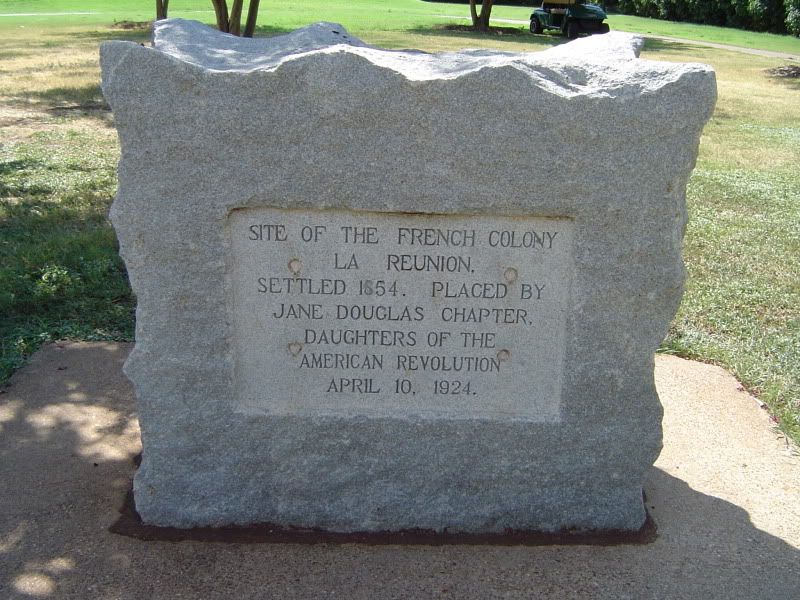
Granite DAR memorial at the Stevens Park golf course, marking the La Reunion site
The DAR memorial is a lovely tribute, but obviously not part of the original colony. For that, travel over to L.G. Pinkston High School at 3345 Fish Trap Road in Dallas and face northwest from the school. You'll be looking at a housing development, and right next to it there is a semi-neglected cemetery that was once known as Fish Trap Cemetery, but a historical marker within the chainlink fence surrounding the cemetery proclaims this the burial site for some of the La Reunion colonists:
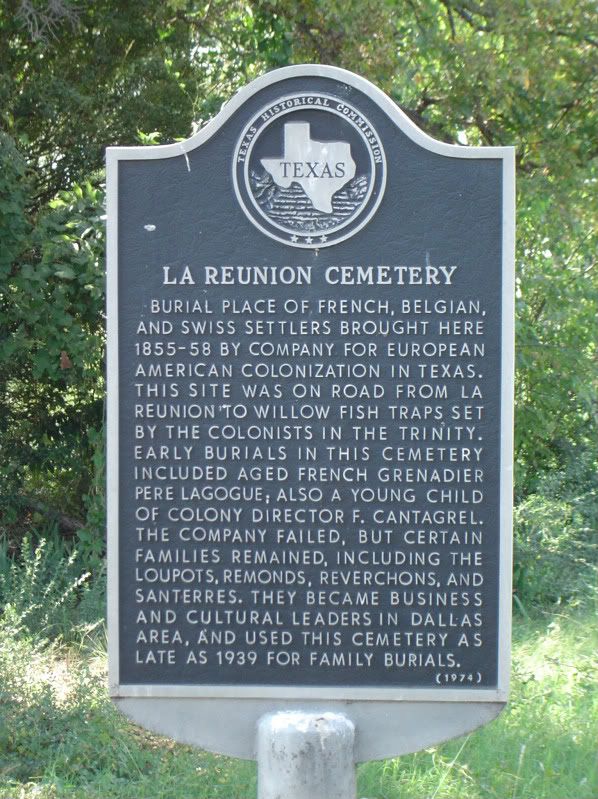
Historical marker for La Reunion Cemetery on Fish Trap Road in Dallas
According to a Dallas Morning News article on La Reunion Cemetery, there has been considerable difficulty finding which agency is responsible for the cemetery's upkeep. Some determined volunteers are doing what they can to tend to the cemetery, and once in a while, some enterprising ghost town chaser finds his way into the cemetery as well. Here are some of the graves at the site:

Tombstone for botanist Julien Reverchon and his wife Marie, both La Reunion colonists; Reverchon Park in Dallas is named in Julien's honor
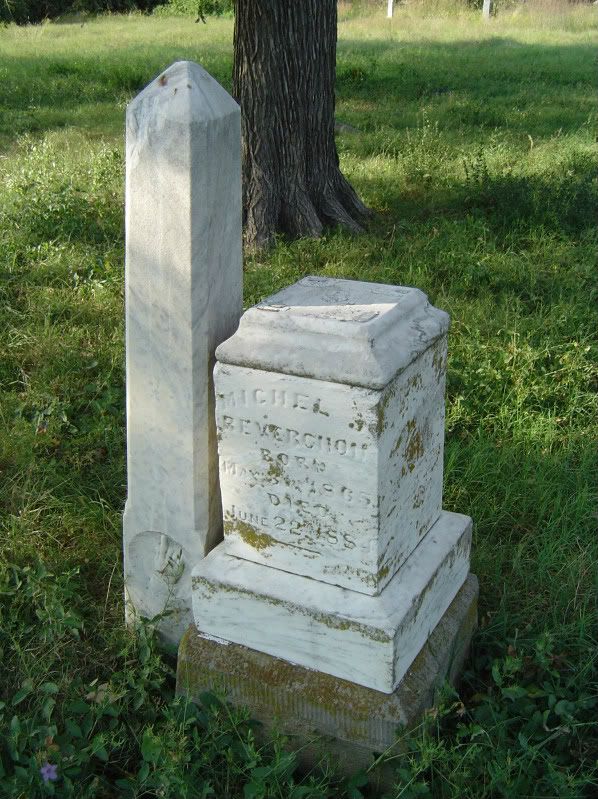
Broken grave marker for Michel Reverchon, son of Julien and Marie Reverchon
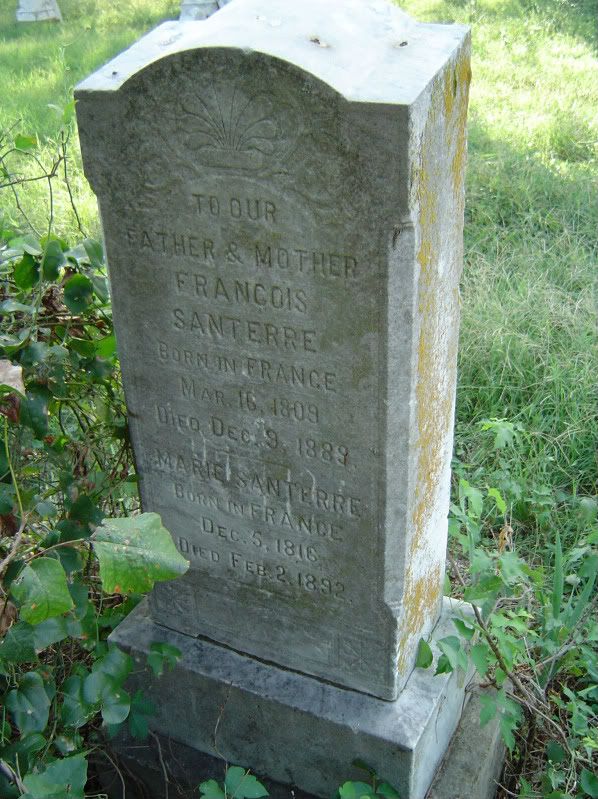
Francois Santerre, one of the most prominent La Reunion colonists, is buried here with his wife, Marie
Not everyone buried at La Reunion Cemetery, however, is a colonist or one of their descendants:
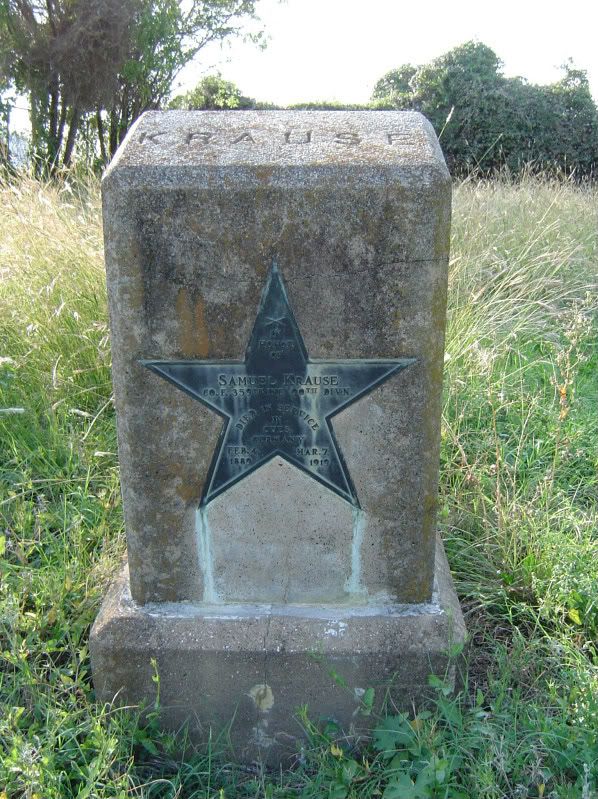
Grave of Samuel Krause, an uncle of Bonnie Parker; Bonnie herself was once interred here before being moved to Crown Hill Cemetery
But what of the ghost town itself? Other than the cemetery, does anything from La Reunion still survive? I'm going to let you in on a little secret:
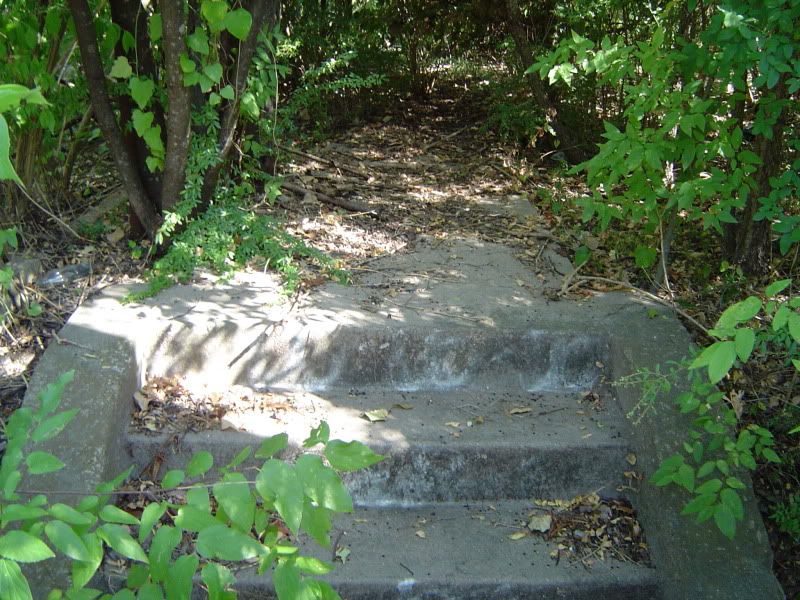
Front steps leading to the remains of the last remaining La Reunion house
Past these steps, on a sidewalk that is covered in dirt and choked with thick vegetation, there once stood a La Reunion colony house that survived all of its neighbors until it collapsed sometime in the 1930s. Even so, something still remains at the old homestead:

Small brick tower, part of the last La Reunion house
Where exactly are the remains of this ghost town house located? The precise location was known to a few schoolchildren in the area who would play there after school; supposedly there are a few more of these sites hiding throughout La Reunion. One of the children who knew of these ruins finally started spreading the word, and eventually the story reached me by means of the Internet, so I travelled to the La Reunion site and did a little exploring of my own until I found this. So I don't feel right just giving up the location, since a handful of Dallasites have made this their little secret. If you wish to find these ruins on your own, I offer this advice: Study the layout and history of La Reunion, drive and hike through the site of the old French colony, and keep your eyes open at all times.
One of these days, however, these last remnants of La Reunion may be swept away. The DAR memorial and the cemetery are safe, but there's a lot of money pouring into this area of Dallas, and with that money comes plans to redevelop the whole neighborhood. When that happens, the ghost town of La Reunion - which managed to survive all of its rivals for all these years - may be eradicated once and for all. So by all means, please go and explore this novel little corner of forgotten Texas history while you have the chance.
Happy Thanksgiving, everybody!
All the other towns have pretty much assimilated into Dallas without leaving any trace of their former selves, and that makes the story of La Reunion all the more fascinating to me. Settled in 1854 and officially founded the next year to serve as a communal society operating on the socio-economic principles espoused by French philosopher Francois Marie Charles Fourier, the town sat on the Trinity River, three miles west of what used to be the village of Dallas. 200 immigrants from France, Belgium, and Switzerland got the project started, and while some of the colonists moved on, there were enough new arrivals to keep La Reunion operating for approximately 18 months, with the population peaking at 350 in late 1856.
La Reunion had everything working against it. The limestone soil proved to be a constant frustration for agriculturists. The colony was plagued with ineffective leadership and disorganization, not to mention financial insolvency. On January 28, 1857, La Reunion was officially dissolved. A few holdouts purchased land on the La Reunion tract and made the site their permanent home, but most colonists either returned to Europe or resettled in Dallas, San Antonio, or New Orleans.
When Dallas expanded westward and swallowed what was left of La Reunion, the townsite was excavated for lime used in the manufacture of concrete, which was sorely needed by the growing city; in fact, the site of La Reunion was incorporated as the town of Cement City for a few decades. Reunion Tower and the now-demolished Reunion Arena were named after the old colony, but at first glance, there seems to be nothing left of La Reunion; instead, there are houses, schools, buinesses, and a golf course in Stevens Park. Walk through the golf course, and you'll see a stone erected by the Daughters of the American Revolution in 1924.

Granite DAR memorial at the Stevens Park golf course, marking the La Reunion site
The DAR memorial is a lovely tribute, but obviously not part of the original colony. For that, travel over to L.G. Pinkston High School at 3345 Fish Trap Road in Dallas and face northwest from the school. You'll be looking at a housing development, and right next to it there is a semi-neglected cemetery that was once known as Fish Trap Cemetery, but a historical marker within the chainlink fence surrounding the cemetery proclaims this the burial site for some of the La Reunion colonists:

Historical marker for La Reunion Cemetery on Fish Trap Road in Dallas
According to a Dallas Morning News article on La Reunion Cemetery, there has been considerable difficulty finding which agency is responsible for the cemetery's upkeep. Some determined volunteers are doing what they can to tend to the cemetery, and once in a while, some enterprising ghost town chaser finds his way into the cemetery as well. Here are some of the graves at the site:

Tombstone for botanist Julien Reverchon and his wife Marie, both La Reunion colonists; Reverchon Park in Dallas is named in Julien's honor

Broken grave marker for Michel Reverchon, son of Julien and Marie Reverchon

Francois Santerre, one of the most prominent La Reunion colonists, is buried here with his wife, Marie
Not everyone buried at La Reunion Cemetery, however, is a colonist or one of their descendants:

Grave of Samuel Krause, an uncle of Bonnie Parker; Bonnie herself was once interred here before being moved to Crown Hill Cemetery
But what of the ghost town itself? Other than the cemetery, does anything from La Reunion still survive? I'm going to let you in on a little secret:

Front steps leading to the remains of the last remaining La Reunion house
Past these steps, on a sidewalk that is covered in dirt and choked with thick vegetation, there once stood a La Reunion colony house that survived all of its neighbors until it collapsed sometime in the 1930s. Even so, something still remains at the old homestead:

Small brick tower, part of the last La Reunion house
Where exactly are the remains of this ghost town house located? The precise location was known to a few schoolchildren in the area who would play there after school; supposedly there are a few more of these sites hiding throughout La Reunion. One of the children who knew of these ruins finally started spreading the word, and eventually the story reached me by means of the Internet, so I travelled to the La Reunion site and did a little exploring of my own until I found this. So I don't feel right just giving up the location, since a handful of Dallasites have made this their little secret. If you wish to find these ruins on your own, I offer this advice: Study the layout and history of La Reunion, drive and hike through the site of the old French colony, and keep your eyes open at all times.
One of these days, however, these last remnants of La Reunion may be swept away. The DAR memorial and the cemetery are safe, but there's a lot of money pouring into this area of Dallas, and with that money comes plans to redevelop the whole neighborhood. When that happens, the ghost town of La Reunion - which managed to survive all of its rivals for all these years - may be eradicated once and for all. So by all means, please go and explore this novel little corner of forgotten Texas history while you have the chance.
Happy Thanksgiving, everybody!
Sunday, November 20, 2011
News story on Old Bluffton site at Lake Buchanan and looting at Lake Whitney
I was in Austin over the weekend, and I really wanted to make a day trip to Lake Buchanan to check out the once-submerged ghost town of Old Bluffton. It just wasn't in the cards this time around, but Associated Press reporters were able to visit the site for a news story. Next time I'm in the Austin area, no more excuses - I'm heading to Old Bluffton, and you know I'll be more than happy to share pictures with you.
The AP article also covers efforts by the Army Corps of Engineers to curtail looting of Native American sites at Lake Whitney that have long been submerged. I condemn the theft of artifacts from these sites, and if by any chance you did remove some of these relics from the Lake Whitney area, what were you thinking? It's the same as if someone ransacked your family plot in search of jewelry or maybe a few gold teeth. Enough, already. My only interest in the Lake Whitney area is in the remains of the submerged ghost town of Towash, nothing more. (D.S., please e-mail me when you can - tried to reach you without success.)
The AP article also covers efforts by the Army Corps of Engineers to curtail looting of Native American sites at Lake Whitney that have long been submerged. I condemn the theft of artifacts from these sites, and if by any chance you did remove some of these relics from the Lake Whitney area, what were you thinking? It's the same as if someone ransacked your family plot in search of jewelry or maybe a few gold teeth. Enough, already. My only interest in the Lake Whitney area is in the remains of the submerged ghost town of Towash, nothing more. (D.S., please e-mail me when you can - tried to reach you without success.)
Tuesday, November 8, 2011
Camden (Gregg County) - January 2011 photos
First things first, I have to give credit to photographer Maryanne Gobble for bringing to my attention a vanishing townsite in East Texas with her photo essay of Camden on the Texas Escapes website, which has a sizable archive of ghost towns complete with lots of pictures.
I was visiting my parents in Mineola back in January of this year, and spurred on by Gobble's photos of what were supposed to be the remains of a very old settlement in Texas, I made a day trip southeast of Longview to the community of Easton, which sits south of the Sabine River in southeastern Gregg County. Once in Easton, I followed the directions supplied by Gobble and turned onto a road that didn't seem to have a name, leading north towards the Sabine River into a clearing dominated by a natural gas pipeline. No road signs, no markers of any kind. Just a forlorn cemetery to my right and a forest with two crumbling houses to my left. Welcome to Camden, aka Walling's Ferry - one of the earliest white settlements in the region.
Sometime in the late 1820s or early 1830s, when Texas was still under Mexican rule, John Walling made his way down to the Sabine River and established a ferry crossing named after himself. The Mexican government licensed Walling's Ferry in the early 1830s. As it was one of the few settled areas in East Texas back in those days, many travelers availed themselves of the ferry when they arrived at Texas, and Sam Houston reportedly stopped at Walling's Ferry when he first entered Texas in 1832. After Texas gained its independence, Walling's Ferry was formally established as a townsite in 1844, the same year that Enoch Hays built an eight-room, two-story tavern at the townsite to accommodate the flow of travelers (but if you wanted a bath, your only option was a dunk in the Sabine River). For many years, Walling's Ferry was also known as Camden, and the town officially changed its name to Camden in 1847 when it obtained its own post office. In those days, Camden was part of Rusk County; the original boundaries of Gregg County, where Camden now sits, weren't drawn until 1873.
Steamboats started coming up the Sabine as far as Camden, which boosted trade for the town; a few plantations at Camden grew cotton and shipped it down the river. This meant that Camden was getting rich, and getting rich quickly - and Enoch Hays was getting a sizable portion of that cash flow. In addition to the tavern, Hays sold cotton grown on his own plantation and took over John Walling's ferry operation in 1850 when Walling left Camden for North Carolina. During the 1850s, Camden featured the Hays tavern/hotel, the post office, a Presbyterian church, a jug factory, a Masonic lodge, and several stores and saloons in addition to the cotton plantations. A telegraph line was also installed at Camden in 1854, one of the first such lines established in Texas; it enabled Camden to coordinate steamboat shipments with Galveston and New Orleans. Although I haven't found any population estimates for Camden during its heyday, Sam Houston made several trips to Camden to attend political rallies, and when Democratic Presidential nominee James Buchanan visited Camden in 1856 for a party function (complete with barbecue), he addressed 10,000 people at the town. Considering that the 1850 census of Rusk County yielded a population of 8,148, this was no small achievement.
Camden's downfall apparently came while the Civil War raged. During this time, Camden was used as a shipping depot for Confederate units to the east, which normally wasn't a problem except that a drought apparently lowered the water level of the Sabine enough to make riverboat navigation problematic. The resulting stagnant pools of water in the river bottoms would prove to be excellent breeding grounds for mosquitoes, who then inflicted themselves upon the townfolk of Camden, bringing malaria and yellow fever with them. In addition, while other East Texas towns replaced their own ferry services with navigable bridges, Camden never followed suit. With new railroad lines being built throughout the region to keep East Texas connected with the rest of the world, the townfolk of Camden simply started packing up and heading out for greener pastures. According to the TSHA, one traveler who visited Camden after the end of the Civil War described the remaining holdouts as "notably inert and melancholy." When the community of Iron Bridge was fully established six miles south of Longview, it reportedly attracted even more Camden residents to resettle there. The post office shut down for good on December 13, 1872, and Camden quickly started disappearing from state maps. Those who were left behind - many of them freed slaves who used to work on Camden's cotton plantations - eventually relocated to the newly-formed sawmill town of Easton, conveniently located on a new stretch of railroad tracks laid down by the Longview and Sabine Valley Railroad Company in 1878. At this point, Camden had become an absolute ghost.
Today, these are the only remains of the once-bustling town of Camden:
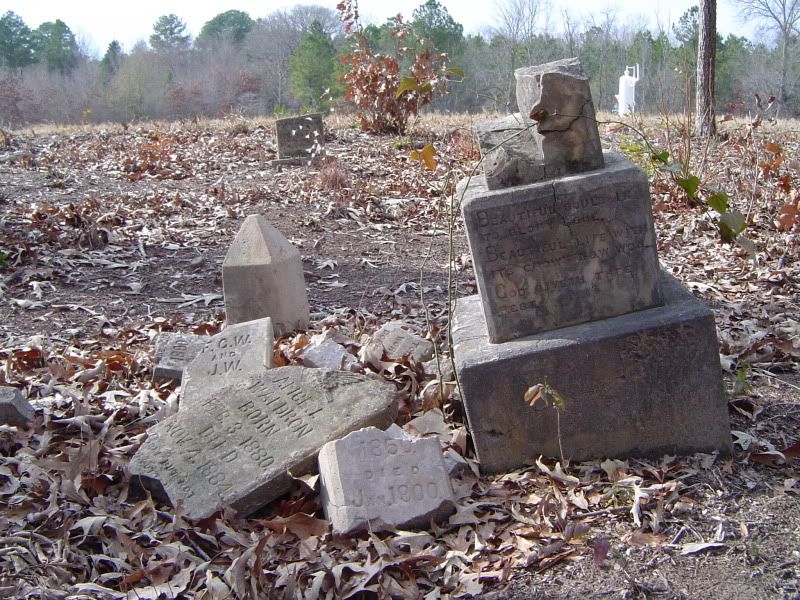
A view of Camden Cemetery, with the natural gas pipeline clearly visible in what used to be the middle of town
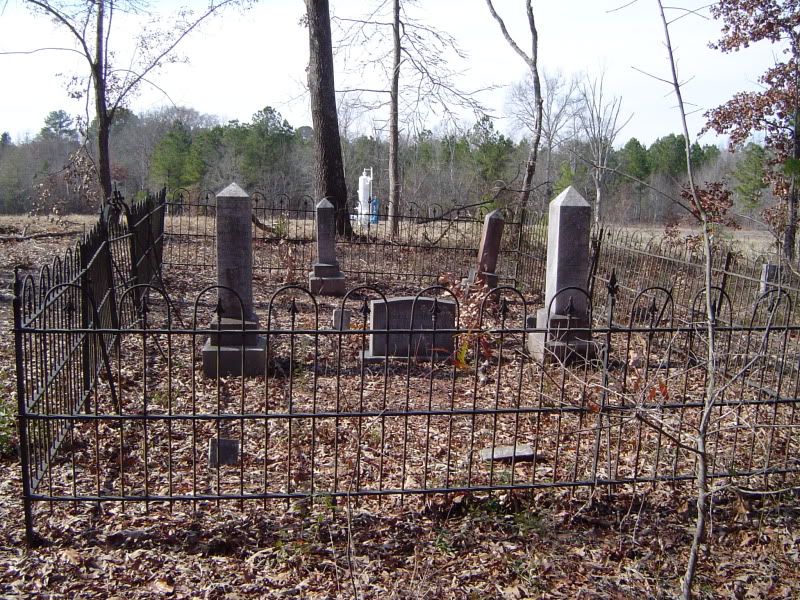
The Waldron family plot at Camden Cemetery
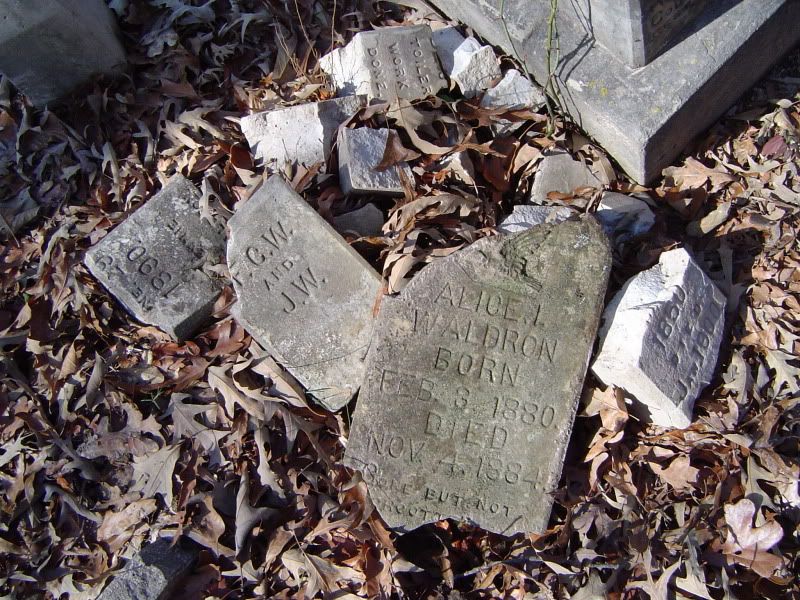
Shattered tombstones at Camden Cemetery; the discovery of shotgun shells nearby suggests vandalism
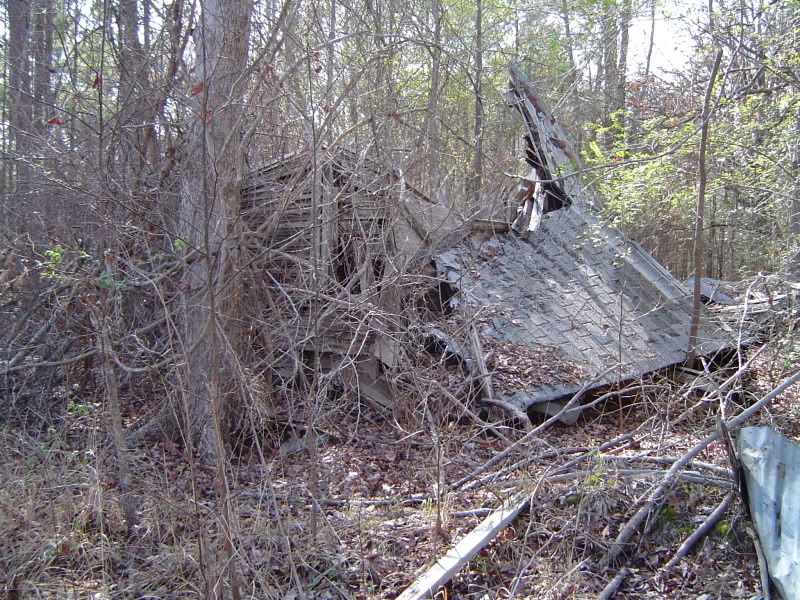
Collapsed remains of a wooden house at Camden
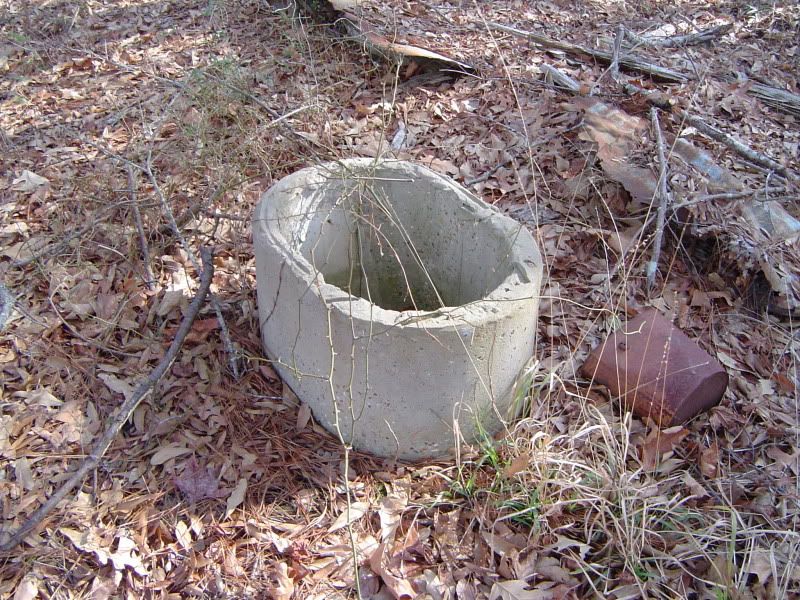
An old well behind the wooden house
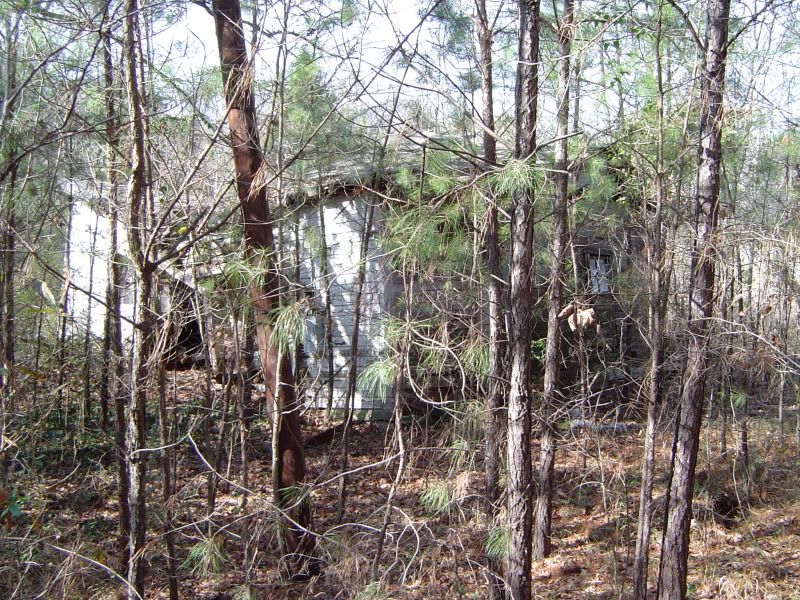
I call this collapsing house the "Camden White House" for want of a better name
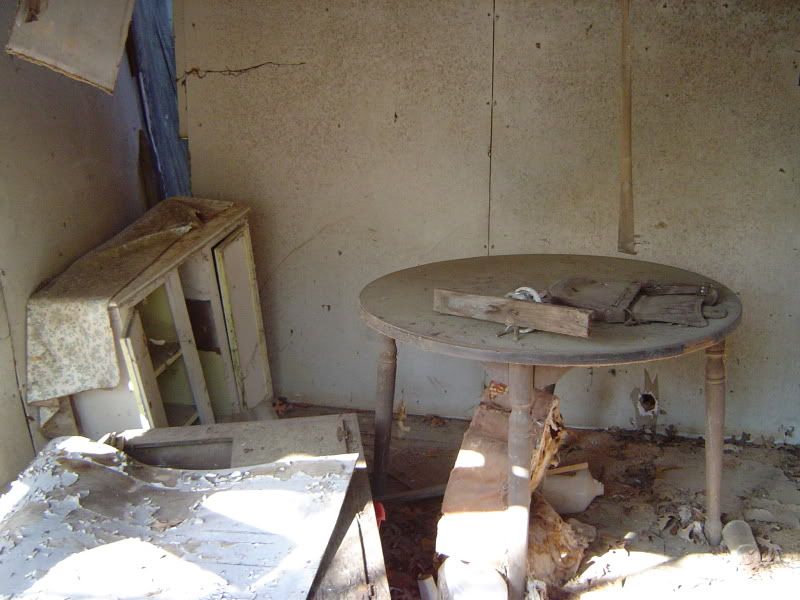
Still life within the kitchen of the Camden White House
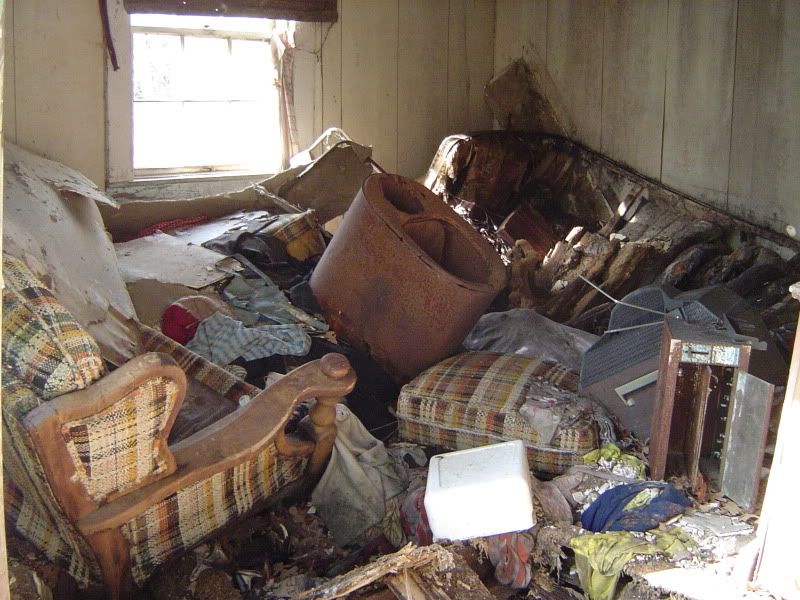
Abandoned furniture and debris in the living room of the Camden White House
It turns out that the January 17, 2011 edition of the Tyler Morning Telegraph published its own article on the history of Camden as well as the development of Easton; it's definitely worth a look. There is now a push by Walter Ward, mayor of Easton, to have the cemetery at Camden officially recognized by Texas as a historical site. I wish him the best of luck.
And Iron Bridge? The irony is that Iron Bridge not only became a ghost town - all traces of the town appear to have vanished completely from the face of the earth, while just enough of Camden remained to be rediscovered by Texas ghost town enthusiasts today.
I was visiting my parents in Mineola back in January of this year, and spurred on by Gobble's photos of what were supposed to be the remains of a very old settlement in Texas, I made a day trip southeast of Longview to the community of Easton, which sits south of the Sabine River in southeastern Gregg County. Once in Easton, I followed the directions supplied by Gobble and turned onto a road that didn't seem to have a name, leading north towards the Sabine River into a clearing dominated by a natural gas pipeline. No road signs, no markers of any kind. Just a forlorn cemetery to my right and a forest with two crumbling houses to my left. Welcome to Camden, aka Walling's Ferry - one of the earliest white settlements in the region.
Sometime in the late 1820s or early 1830s, when Texas was still under Mexican rule, John Walling made his way down to the Sabine River and established a ferry crossing named after himself. The Mexican government licensed Walling's Ferry in the early 1830s. As it was one of the few settled areas in East Texas back in those days, many travelers availed themselves of the ferry when they arrived at Texas, and Sam Houston reportedly stopped at Walling's Ferry when he first entered Texas in 1832. After Texas gained its independence, Walling's Ferry was formally established as a townsite in 1844, the same year that Enoch Hays built an eight-room, two-story tavern at the townsite to accommodate the flow of travelers (but if you wanted a bath, your only option was a dunk in the Sabine River). For many years, Walling's Ferry was also known as Camden, and the town officially changed its name to Camden in 1847 when it obtained its own post office. In those days, Camden was part of Rusk County; the original boundaries of Gregg County, where Camden now sits, weren't drawn until 1873.
Steamboats started coming up the Sabine as far as Camden, which boosted trade for the town; a few plantations at Camden grew cotton and shipped it down the river. This meant that Camden was getting rich, and getting rich quickly - and Enoch Hays was getting a sizable portion of that cash flow. In addition to the tavern, Hays sold cotton grown on his own plantation and took over John Walling's ferry operation in 1850 when Walling left Camden for North Carolina. During the 1850s, Camden featured the Hays tavern/hotel, the post office, a Presbyterian church, a jug factory, a Masonic lodge, and several stores and saloons in addition to the cotton plantations. A telegraph line was also installed at Camden in 1854, one of the first such lines established in Texas; it enabled Camden to coordinate steamboat shipments with Galveston and New Orleans. Although I haven't found any population estimates for Camden during its heyday, Sam Houston made several trips to Camden to attend political rallies, and when Democratic Presidential nominee James Buchanan visited Camden in 1856 for a party function (complete with barbecue), he addressed 10,000 people at the town. Considering that the 1850 census of Rusk County yielded a population of 8,148, this was no small achievement.
Camden's downfall apparently came while the Civil War raged. During this time, Camden was used as a shipping depot for Confederate units to the east, which normally wasn't a problem except that a drought apparently lowered the water level of the Sabine enough to make riverboat navigation problematic. The resulting stagnant pools of water in the river bottoms would prove to be excellent breeding grounds for mosquitoes, who then inflicted themselves upon the townfolk of Camden, bringing malaria and yellow fever with them. In addition, while other East Texas towns replaced their own ferry services with navigable bridges, Camden never followed suit. With new railroad lines being built throughout the region to keep East Texas connected with the rest of the world, the townfolk of Camden simply started packing up and heading out for greener pastures. According to the TSHA, one traveler who visited Camden after the end of the Civil War described the remaining holdouts as "notably inert and melancholy." When the community of Iron Bridge was fully established six miles south of Longview, it reportedly attracted even more Camden residents to resettle there. The post office shut down for good on December 13, 1872, and Camden quickly started disappearing from state maps. Those who were left behind - many of them freed slaves who used to work on Camden's cotton plantations - eventually relocated to the newly-formed sawmill town of Easton, conveniently located on a new stretch of railroad tracks laid down by the Longview and Sabine Valley Railroad Company in 1878. At this point, Camden had become an absolute ghost.
Today, these are the only remains of the once-bustling town of Camden:

A view of Camden Cemetery, with the natural gas pipeline clearly visible in what used to be the middle of town

The Waldron family plot at Camden Cemetery

Shattered tombstones at Camden Cemetery; the discovery of shotgun shells nearby suggests vandalism

Collapsed remains of a wooden house at Camden

An old well behind the wooden house

I call this collapsing house the "Camden White House" for want of a better name

Still life within the kitchen of the Camden White House

Abandoned furniture and debris in the living room of the Camden White House
It turns out that the January 17, 2011 edition of the Tyler Morning Telegraph published its own article on the history of Camden as well as the development of Easton; it's definitely worth a look. There is now a push by Walter Ward, mayor of Easton, to have the cemetery at Camden officially recognized by Texas as a historical site. I wish him the best of luck.
And Iron Bridge? The irony is that Iron Bridge not only became a ghost town - all traces of the town appear to have vanished completely from the face of the earth, while just enough of Camden remained to be rediscovered by Texas ghost town enthusiasts today.
Subscribe to:
Posts (Atom)